Retail marketing: Research reveals key strategies for success in a shifting landscape
With currently over five billion people connected online and worldwide access rapidly expanding, the number of individuals engaging in online shopping continues to climb at a record pace

One of the most notable trends in e-commerce is the unprecedented dominance of mobile devices: m-commerce. Towards the end of 2022, smartphones accounted for more than 70% of all retail website visits worldwide, and they generated the majority of online orders, surpassing desktops and tablets. With the rapid adoption of mobile devices, especially in regions with limited digital infrastructure, mobile integration will continue to shape the future of the online shopping experience.
Notably, m-commerce has gained immense popularity in Asia, with populations in China and South Korea generating over two-thirds of their total online sales through mobile devices.
Challenges & the evolving landscape of retail brands
Impacted by the dramatic rise of both e-commerce and now m-commerce, consumer packaged goods (CPG) and retail brands have found themselves grappling with this sea of change. The rise of online consumption, a shortened path to purchase, dwindling brand loyalty, and ever-evolving consumer preferences have presented unique challenges for brands.
What lies at the heart of these transformations? The ease of discovery.
Gone are the days when consumers relied solely on traditional marketing like TV commercials and display ads at the top of the funnel and search results at the bottom to guide their purchasing decisions. Social media in particular has shifted consumer behavior to an expectation of greater convenience.
The tried-and-true approach of combining upper funnel brand advertising with lower funnel performance ads to drive website traffic has slowly eroded. Instead, consumers now seek the instant gratification provided by a more streamlined experience that allows them to make a purchase directly from an upper funnel brand ad.
On social media platforms like Meta, consumers can seamlessly transition from browsing to buying, bypassing the traditional steps in the consumer journey with just a few taps on their screens.
With the wealth of options available at their fingertips, consumers have become more discerning, and as a result, brands need to provide exceptional experiences that cater to new consumer preferences. They expect personalized recommendations, tailored promotions, and a seamless shopping experience. Brands that fail to deliver risk losing customers to competitors who can meet these elevated expectations.
The shortened path to purchase requires brands to capture consumer attention earlier on in the buying process. As consumers become more adept at discovering new products and researching their options online, the importance of establishing a strong brand presence at the upper funnel stage cannot be overstated. Brands must find innovative ways to captivate consumers and entice them to make a purchase immediately, directly from the initial touchpoint.
How to overcome these challenges
When it comes to advertising, this evolving landscape presents a challenging and exciting opportunity for CPG and retail brands - to succeed, their ads need to drive both awareness and conversion in a single impression.
Brands must create engaging and actionable experiences right from the first exposure. Restricting consumer activities during engagements can result in missed potential and frustrated customers who may turn to competitors. To understand these new behaviors and gain support and credibility for this new approach, Kargo, SmartCommerce, and MediaScience conducted research to explore the collapsed journey of buying directly from branding ads.
The study’s purpose was multifaceted: quantify the value of shoppable ad units compared to standard banners, identify effective drivers of conversions, and gain consumer feedback on the overall e-commerce experience. MediaScience employed various metrics such as eye tracking to measure visual attention, which revealed the significance of bigger ad formats like Kargo’s unique Venti and Breakaway ad formats. These creatives garnered longer viewing times and higher fixations, leading to better aided and unaided brand recall.
Brand attitude emerged as another critical factor in the study. Approximately 70% of customers exposed to click-to-cart activations displayed a positive brand attitude after interacting with the ads - marking a 25% increase compared to standard ads. Additionally, the click-to-cart element had a significant impact on purchase intent with nearly half of the surveyed customers expressing their willingness to complete the purchase following exposure to click-to-cart and shopper's choice activations. This exceptional completion rate outperformed traditional click-to-site e-commerce metrics.
This study resulted in three key takeaways.
First, this research demonstrated the importance of coupling high-impact ads that drive brand recognition and awareness with frictionless shopping technology to drive a major lift in conversions immediately from the first impression.
Next, purpose-built, mobile-centric creative executions were found to be twice as effective as standard banners.
And finally, personalizing post-click experiences and prioritising quicker, more convenient user experiences were identified as crucial drivers of purchase intent.
As the CPG and retail industry continue to adapt to the evolving consumer landscape, embracing these insights and implementing innovative strategies will be vital for brands to navigate the challenges and leverage the exciting opportunities presented by the collapse of the traditional marketing funnel.
By focusing on convenience, personalisation, impactful ads, and contextually relevant environments, brands can enhance their brand presence, drive conversions, and thrive in the ever-changing e-commerce landscape with more engaging creative that captures attention and drives conversion from the first impression.

